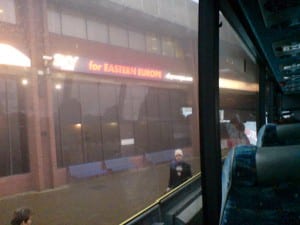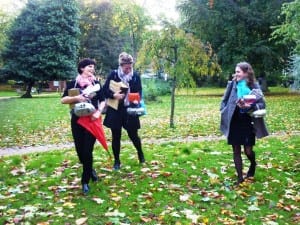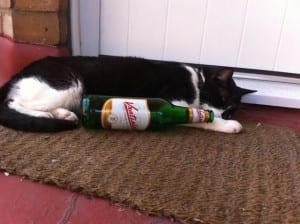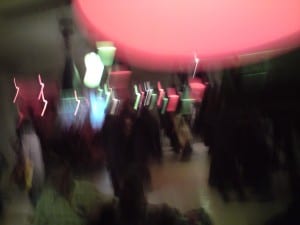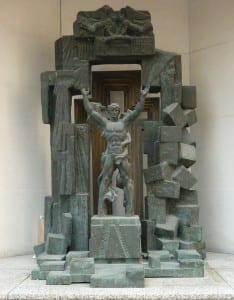Storming the Winter Palace
By Sarah J Young, on 20 December 2013
Storming the Winter Palace, a SSEES languages and culture photo competition on the theme of Russian and East European London, led students and staff to contemplate cultural resonances, contemporary identities and stereotypes – and language-learning opportunities! In the final post of the year on the SSEES Research Blog, Sarah Young introduces a selection of entries. Commentaries are by the photographers, unless otherwise stated.
Harbry Ellerby’s photograph of the Hungarian stall in Camden reminds Eszter Tarsoly that every encounter with Eastern European food in London invites us to reflect on cultural exchange, language, and translation:
The photographer took this shot in front of the Hungarian stall in Camden Town. The food on sale here, instead of the grilled sausages more usual on Polish and other East European stands, is lángos, a deep-fried flat bread whose dough is similar to that of pizza. It is traditionally seasoned with garlic and tejföl, a wide-spread diary product in Eastern Europe known in various guises in the region (e.g. Romanian smântână and Czech smetana) and most similar perhaps to soured-cream. How much a simple, hearty food – particularly recommended after a long, hearty night – can teach us about translation! The man’s silouette in front of the stall and the hanging flower baskets are revealing: the image, while entirely authentic, could have been taken only on a somewhat manicured market. This video clip of the song ’Lángos, tejföl’ by the band Kaukázus shows how lángos is enjoyed in Hungary.
Seeing a street sign commemorating one of the many Eastern European revolutionaries who lived in London during the nineteenth century, Eszter Tarsoly‘s thoughts turn to today’s immigrants:
In a quiet, respectable, yet exhilarating corner of Greenwich stretches a modest Cul-de-Sac called Kossuth Street, named after Hungary’s larger-than-life revolutionary hero, one of the driving forces behind the 1848-49 Revolution and War of Independence. Lajos Kossuth, after the demise of that Revolution, resided briefly in Britain, and legend has it that he stunned English-speaking audiences with his knowledge of English acquired in prison, or rather, with the kind of English he had acquired (only from written texts) in prison. We do not know exactly what Kossuth’s English was like. But not far from Kossuth Street, just across the Thames near Limehouse basin, there are entire blocks of flats inhabited almost exclusively by Kossuth’s contemporary compatriots, sharing overcrowded accommodation, having little hope – in the absence of knowing good English or who knows what other skills – to move on. A dead end…?
The reality of contemporary immigration from Eastern Europe is the subject of the first of two photographs by Ger Duijzings:
This image was taken during a cold night in February 2012 at just after 3 in the morning, at a bank branch opposite Victoria Station. Together with my research student Cezar Macarie I was doing a night walk around the area. Underneath a row of ‘fast, easy, and convenient’ cashpoints, in the glass protected bank area, a dozen or so Poles and Romanians are sleeping rough. As it is outside of official opening hours, the automatic door is kept open by a traffic cone. A Pole smoking a cigarette in front told us that he had been working in London for seven years, the first five years on a contract, but the last two working on-and-off.
Ger Duijzings’ second entry confronts insular British views of Europe and the question of what ‘Eastern Europe’ means in this country:
A quick snap shot taken at the end of November 2007 at Luton Airport which shows how outdoor advertising at UK airports targets low-budget travellers from East Europe. I had just returned from one of my frequent commutes to so-called ‘Eastern’ Europe which for some natives in the British isles apparently starts just across the North Sea. I took the photo from the inside of a bus waiting to take me into Central London. A lone individual is about to put his luggage into the belly of a bus: it may have been an East European guest worker or student, perhaps. The cold and grey image has the impersonal and slightly gloomy quality of what Marc Augé would call a ‘non-place’.
First prize winner Richard Morgan’s portrait ‘Newspaper’ asks us who can get to know whom: Ukraine, England, or his friend:
My friend from the Sorbonne was visiting. In the mornings she would read the paper by the window. She used it as a shield against the new day. When it bored her she liked to peer over the top and stare at me. I told her that there was a photo competition at my university, that I had no ideas, and that because she had beautiful eyes her portrait would probably do quite well. She asked me if it had to be real.
A self-portrait by East-European language-teaching fellows Ula Chowaniec, Lucie Wiseman, and Eszter Tarsoly emphasizing language as a means of knowing the other:
Teaching Fellows from Eastern Europe who work at SSEES felt challenged by the theme of the photo competition – ’Russian and East European London’ – to reflect on their own position: East European language specialists in London, specialists in East European languages in London, a special part of the landscape of East European London? They are people who believe that the place of the attribute makes a difference even in simple noun phrases, in the languages of London and of Eastern Europe. Without language there is no way of knowing what the other is trying to say. Without language how would we know what the Other means?
Elisabeth Gheorghe’s second prize winning photo ‘Czech Clive’ comments on cultural stereotypes of Eastern Europe to ask what we know of the Other, and how:
The title was chosen due to the alliteration in the two words (my cat is named Clive, and the beer coincidentally was a Czech pilsner). That particular Sunday afternoon, when the photo was taken, I found myself in a fascinating discussion about ways in which the Middle East is stereotypically conveyed in Western media. There were examples of how Saudi Arabian stand-up comedians satirize their government’s views of the West and other Arab states. A topic that caught my attention was how EU citizens from the new East European member states have been represented in the media. The aim of the photo was to conjure up a satirical portrayal of how the SSEES region is stereotypically viewed: a bottle of beer next to a delirious Clive matches the anticipated regional stereotype.
Cultural stereotypes become abstract art in Gigi Ducescu’s street party image:
I am sending you four hazy images I took being pretty drunk after several shots of vodka at the Poland Street Underground Party sponsored by Wyborova and the Polish Cultural Institute in September 2008. I have a whole lot more images like that…
For Guo Mo, whose photo won third prize, vodka on a supermarket shelf also acts a sign of how embedded Russian culture is in British life:
I found “Standard vodka” in Waitrose near my home, and took a picture of it. I was thinking of the connections with Dmitry Mendeleev, who supposedly defined the 40% standard for Russian vodka, so saw this as representing an important part of Russian tradition and history. As a foreigner, I have never seen any truly Russian brand of vodka in a supermarket in China, so I was really surprised when I first saw Standard in a London supermarket. I took the photo not only because Russian vodka is sold in the UK, but also because it acts as a kind of symbol of Russian culture.
Sarah Young’s images focus on the marks Russian culture leaves on London, and the art world, both temporary and permanent. The discovery of a socialist-realist art work in the City leaves her nonplussed:
I often go in search of traces of Russian history and culture in London, but in summer 2011 I came across Zurab Tsereteli’s 1990 sculpture ‘Break the Walls of Mistrust’ on Cannon Street completely by chance, on my way to St Paul’s for the start of a Dickens-themed walk to Wapping. Inconspicuous by Tsereteli’s standards, and incongruous – a piece of late Soviet kitsch commissioned by a property developer in the City of London? – I wonder how many people walk past this every day without even noticing it.
And a classic of the Soviet avant-garde overturns previous artistic conceptions:
The Royal Academy’s ‘Building the Revolution’ exhibition in 2012, in addition to evocative photographs of crumbling constructivist buildings, featured a reconstruction of the movement’s most famous unbuilt masterpiece, Vladimir Tatlin’s Monument to the Third International. I liked the juxtaposition of the tower with the poster for the Degas exhibition and the statue of Sir Joshua Reynolds, representing three different artistic eras in one space. Does Tatlin’s tower overpower the other two, as the enormous construction itself would have, had it ever been built?
With thanks to the contributors for the use of their images and text. All images are licensed under a Creative Commons Attribution NonCommercial ShareAlike 3.0 Unported License.
Note: This article gives the views of the author(s), and not the position of the SSEES Research blog, nor of the School of Slavonic and East European Studies, nor of UCL.
The SSEES Research Blog will return in the new year.
 Close
Close





